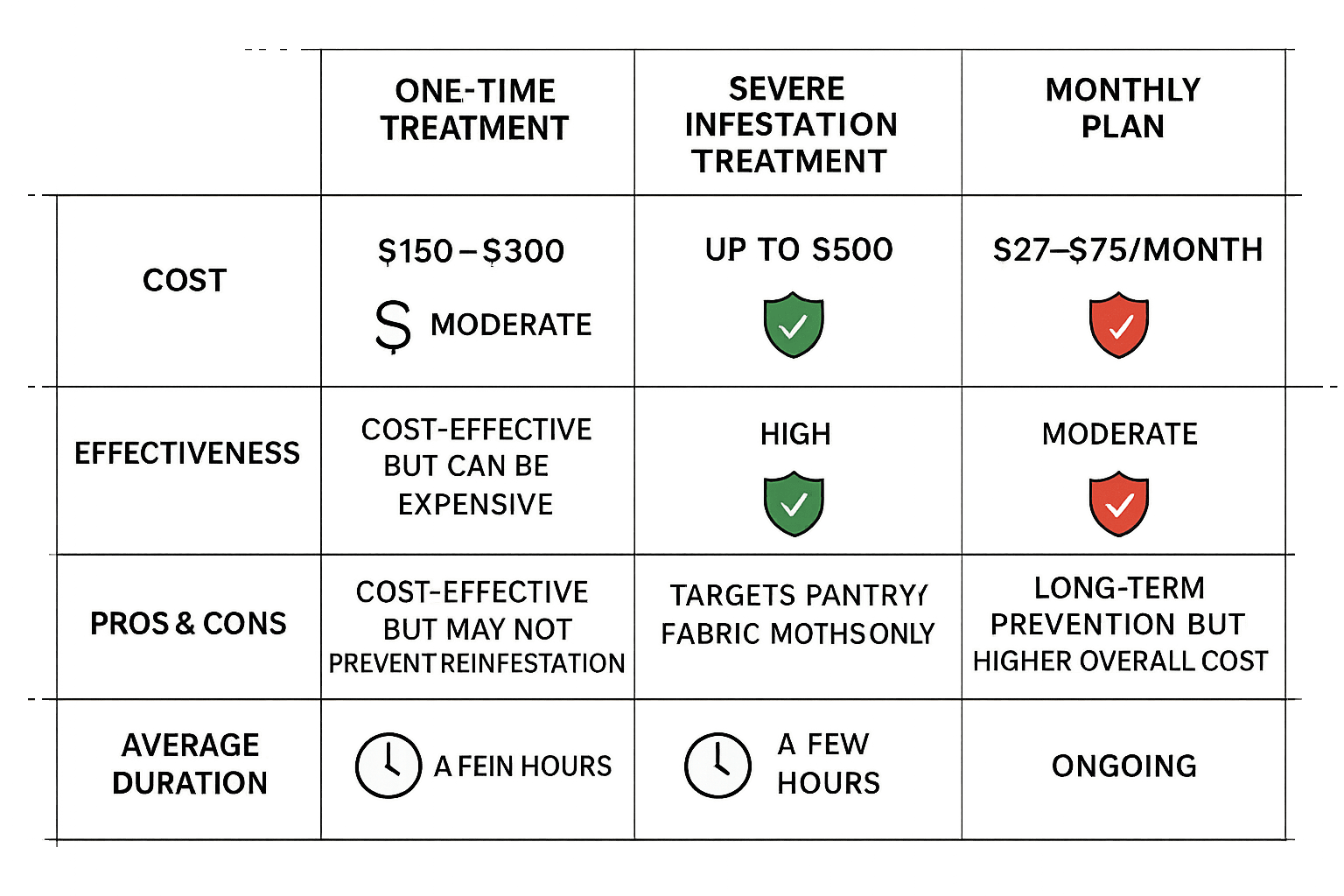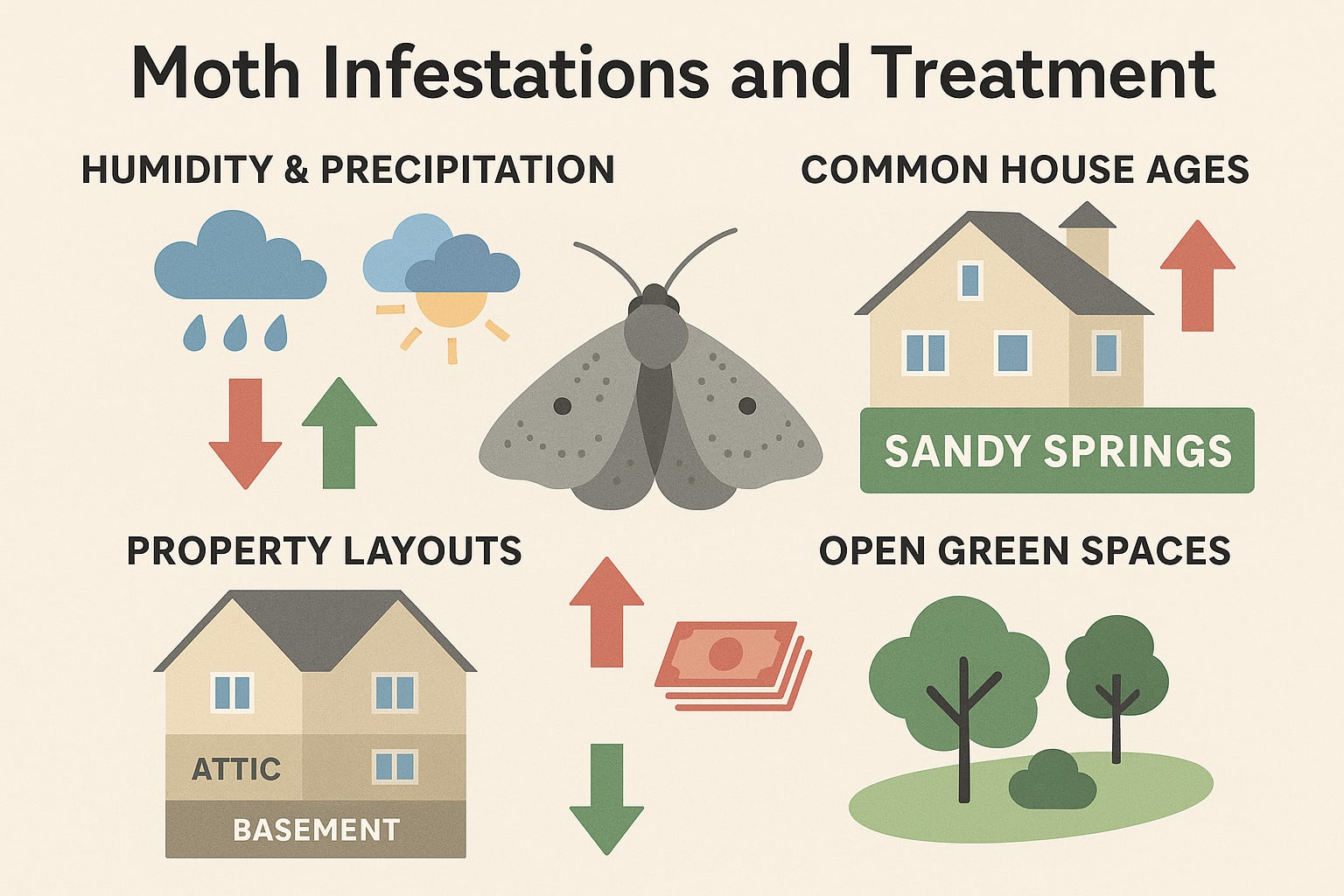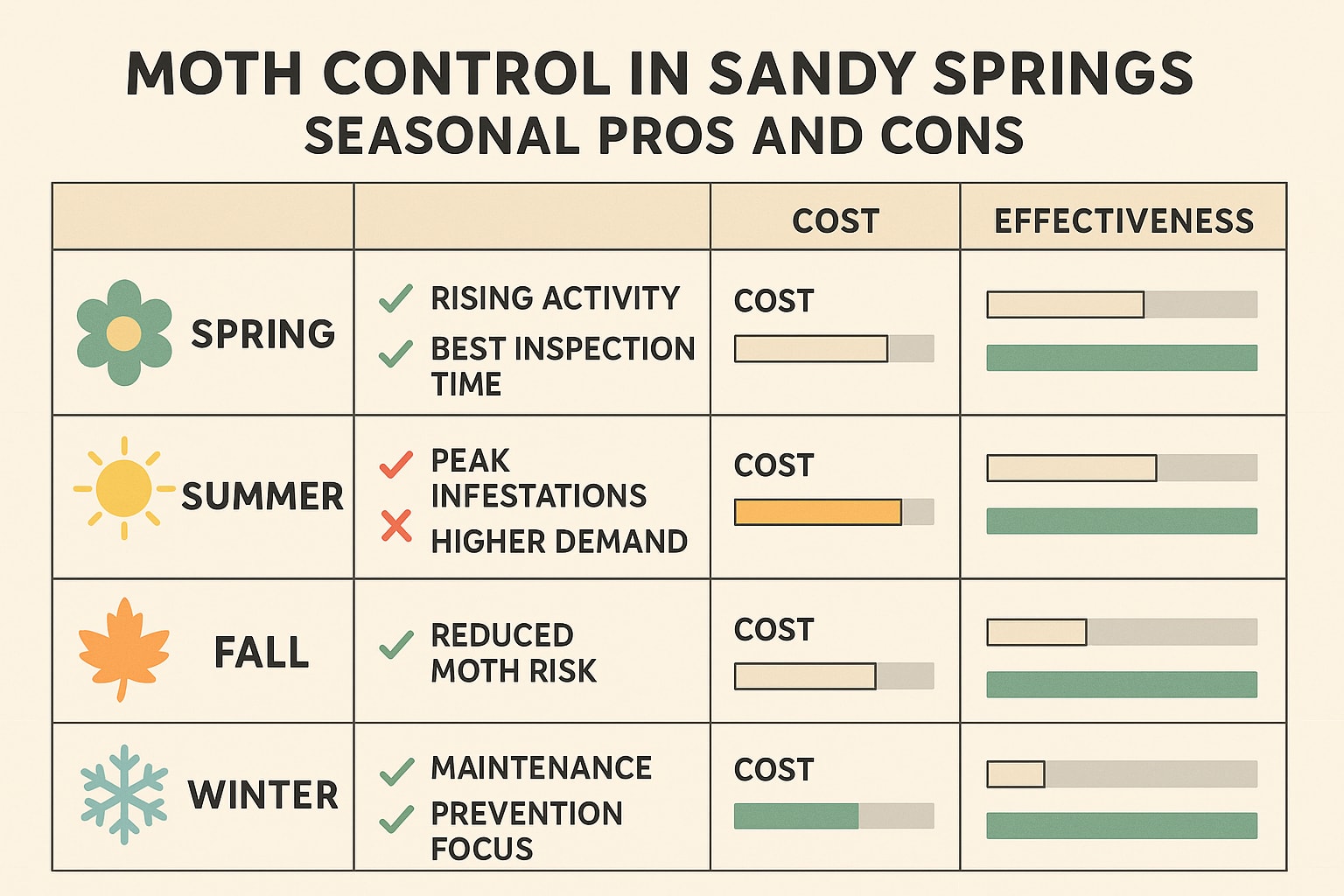Moth Infestations: A Real Challenge in Sandy Springs Homes
Moth control cost Sandy Springs is more essential than most residents realize. If you’re a Sandy Springs local, you know that life here means enjoying wooded neighborhoods, bustling new developments, and the kind of Southern weather that’s ideal—unfortunately, also for moths. Whether it’s food moths sneaking into your pantry or clothes moths eating away at your favorite sweaters, these pests are more than just a mild annoyance. They love our city’s humid, subtropical air, and with mature areas like Riverside or Huntcliff blending with new builds, every home is at risk—even those you wouldn’t expect.
Here’s the thing: Many folks in Sandy Springs are shocked by how quickly moth problems can get out of hand. One overlooked bag of flour or a forgotten coat in a closet is enough to turn a minor inconvenience into a headache. And the costs can add up faster than you’d think. You’re looking at $150 to $300 for a standard one-time moth treatment, but if things really get out of hand, the bill can jump to $500 just to get back to square one. For homeowners and renters who want to stay ahead of it, monthly pest plans (which often include moth coverage) run from $27 to $75, depending on the provider and size of your place. Some companies check things out for free, others ask up to $200 for a thorough inspection—so it pays to know your options.
Why should you care about moths? Well, besides the damage to your food, clothes, and even business reputation, ignoring a moth problem only makes it worse. It’s not just about cost; it’s about your comfort and peace of mind. Think of moth control as a way to protect your investment, save time, and avoid future surprises.
- Food safety: Pantry moths can contaminate your groceries in no time flat.
- Wardrobe worries: Clothes moths can leave expensive damage behind before you even notice they’re there.
- Resale value: Persistent pests don’t look great to buyers or tenants.
This guide will walk you through exactly what you can expect in terms of pricing, treatment choices, and prevention strategies, all tailored for Sandy Springs. Ready to put moth problems in your rearview mirror? Let’s break down how you can stay protected—and what you should be budgeting for top-notch peace of mind.
What Impacts of Moth Control Cost Sandy Springs?
Ever wondered why prices for moth control can be all over the place in Sandy Springs? It comes down to a handful of real, practical factors our team sees every day on the job.
- The Size of Your Home or Business: A small condo facing a pantry moth situation is going to cost less to treat than a sprawling house with moths tucked into closets, attics, and basements. More space means more work and materials.
- Severity of the Infestation: If you’ve just noticed a couple of moths fluttering near your kitchen, that’s a simple fix. But if you’re already seeing holes in your sweaters or damaged rugs, you’re looking at a deeper infestation, which takes more time and resources to handle right.
- How Fast You Need Service: Nobody likes waiting around when moths are invading your home. Emergency or same-day solutions are available, but be prepared—they usually come with a higher price tag thanks to scheduling and rapid response needs.
- Treatment Preferences: Eco-conscious folks may opt for low-toxicity or eco-friendly moth control options. These tend to cost a bit more than your standard chemical spray but can be worth it for peace of mind—especially for homes with kids or pets.
- The Age and Structure of the Property: In Sandy Springs, neighborhoods like Dunwoody Panhandle or North Springs are filled with houses that have decades of character—and, in some cases, structural quirks that give moths more places to hide. Older construction can mean more labor and higher costs.
Let’s talk numbers, since no one likes surprises. For a standard single visit, you’re usually looking at $150–$300. If you need a specialized service—like targeting moths in delicate fabrics or antiques—expect to pay between $200–$275. Many residents find peace of mind in ongoing protection, with plans ranging from $27–$75 per month, depending on service level and frequency.
Don’t forget inspection fees. While Anthem Pest Control and a few others offer free inspections, some companies do charge for their expertise upfront—typically between $100–$200. Always ask if that fee is applied toward treatment if you decide to move forward.
Every home and situation is different, and transparent pricing helps you make the best choice. If you’re in Sandy Springs and want the most accurate estimate, let us know what you’re seeing, and we’ll point you in the right direction—no pressure, just honest advice.
What Impacts the Cost of Moth Control in Sandy Springs?
Ever wondered why prices for moth control can be all over the place in Sandy Springs? It comes down to a handful of real, practical factors our team sees every day on the job.
- The Size of Your Home or Business: A small condo facing a pantry moth situation is going to cost less to treat than a sprawling house with moths tucked into closets, attics, and basements. More space means more work and materials.
- Severity of the Infestation: If you’ve just noticed a couple of moths fluttering near your kitchen, that’s a simple fix. But if you’re already seeing holes in your sweaters or damaged rugs, you’re looking at a deeper infestation, which takes more time and resources to handle right.
- How Fast You Need Service: Nobody likes waiting around when moths are invading your home. Emergency or same-day solutions are available, but be prepared—they usually come with a higher price tag thanks to scheduling and rapid response needs.
- Treatment Preferences: Eco-conscious folks may opt for low-toxicity or eco-friendly moth control options. These tend to cost a bit more than your standard chemical spray but can be worth it for peace of mind—especially for homes with kids or pets.
- The Age and Structure of the Property: In Sandy Springs, neighborhoods like Dunwoody Panhandle or North Springs are filled with houses that have decades of character—and, in some cases, structural quirks that give moths more places to hide. Older construction can mean more labor and higher costs.
Let’s talk numbers, since no one likes surprises. For a standard single visit, you’re usually looking at $150–$300. If you need a specialized service—like targeting moths in delicate fabrics or antiques—expect to pay between $200–$275. Many residents find peace of mind in ongoing protection, with plans ranging from $27–$75 per month, depending on service level and frequency.
Don’t forget inspection fees. While Anthem Pest Control and a few others offer free inspections, some companies do charge for their expertise upfront—typically between $100–$200. Always ask if that fee is applied toward treatment if you decide to move forward.
Every home and situation is different, and transparent pricing helps you make the best choice. If you’re in Sandy Springs and want the most accurate estimate, let us know what you’re seeing, and we’ll point you in the right direction—no pressure, just honest advice.
How Sandy Springs Homes and Environment Shape Moth Problems (and Prices)
Moth Control Sandy Springs is an important consideration, especially because our summers get muggy and our winters stay pretty tame—perfect conditions for moths to settle in and stick around all year long. If your house is tucked into leafy spots like Riverside or hugs the Chattahoochee, chances are higher you’ve spotted pantry or closet moths making themselves at home. In these neighborhoods with lots of tree cover and nearby water, moths thrive outside and easily sneak indoors.
The bones of your house matter, too. Older places, even ones lovingly maintained, often have little cracks or gaps around doors, windows, and in the foundation. These tiny entry points are more than enough for moths to find their way in. Add in features like big walk-in closets, attics, or basements (places where we all tuck away winter coats and old blankets), and you’ve got prime real estate for moths to hide and breed. If you have a pantry that isn’t sealed up tight or store lots of dry goods, you’re basically putting out a welcome mat for pantry moths as well.
Another factor? We’re right next to Atlanta. That means more frequent movement of pests along highways and neighborhoods, so even if you tackle a moth problem now, there’s always a chance of new moths coming in from nearby homes or businesses.
All of these elements—structure, storage habits, neighborhood, and regional pest movement—shape both the strategy and the cost for getting moths out (and keeping them gone). Sometimes, straightforward treatment just won’t cut it. Special products for cracks, extra visits, or longer-lasting solutions may be necessary. Got an older home with a big yard and closets packed to the brim? The price could be a little higher simply because there’s more ground to cover and more hiding spots to check. Live in a newer apartment with climate-controlled closets and tight seals? You might get by with a simpler service.
Bottom line: where you live in Sandy Springs and what your home looks like really does play into how tricky (and how much) it is to get rid of moths for good. Next, let’s break down visually how these factors come together for your specific moth control plan.
Easy Steps to Prevent Moth Problems and Save Money Long-Term
Let’s be honest: most folks in Sandy Springs don’t think about moths until little holes show up in a favorite sweater, or pantry staples get spoiled. But here’s the thing—prevention is way cheaper and easier than dealing with a full-blown moth invasion. A few smart habits can save you a fortune in future pest control.
- Store food tight: Throw dry goods like grains, cereal, or pet food into airtight containers as soon as you bring them home. That simple step keeps hungry pantry moths out for good.
- Declutter and deep clean: Moths love dark, undisturbed corners—especially in the closets of older homes in neighborhoods like Glenridge or North Springs. Regularly vacuum those hard-to-reach spots, and give your closet a little attention too. Every so often, launder blankets, winter clothes, or linens you don’t use often.
- Seal every crack: Walk around your place and check for gaps around windows or walls. A small crack is all it takes for moths to sneak in. Grab some caulk or weatherstripping and seal things up.
- Take care of your textiles: Got a few high-value sweaters or keepsake quilts? Consider storing them in cedar chests or use cedar blocks. Moth-repellent sachets (the kind you toss in with your clothes) can help too, especially in areas you don’t check very often.
- Stay on top of inspections: Don’t wait until you see signs of damage. Schedule a professional pest inspection once or twice a year, ideally before moth season kicks off. Catching issues early means quicker (and less expensive) fixes.
By keeping your home decluttered, sealing things up, and staying proactive with seasonal inspections, you’ll dodge the stress (and cost) of a serious moth problem. A few changes now mean your favorite wardrobe pieces and kitchen staples are safe—and your wallet thanks you. Ready for even more peace of mind? Scroll on for a quick checklist that will let you see how your seasonal prevention strategies stack up.
Get the Timing Right for Moth Control in Sandy Springs
If you’re tired of moths getting the upper hand every year, here’s a little secret: when you act makes all the difference in the world. In Sandy Springs, moths really start showing up in late spring when things get warm and humid – that’s their cue to move in and multiply. By summer, you’ve not only got more moths, but you’re also likely to face bigger bills if you call for help at the hottest, busiest time.
The locals who never seem to get hit with a moth problem? They’re usually the folks who book a professional inspection or treatment in early spring. That’s when the first wave of moths is setting up shop, and it’s the sweet spot to catch them before they explode in numbers. Taking care of things early means fewer headaches and saves you money because demand (and prices) spike once the summer rush begins—especially right after a good heatwave or when storms crank up the humidity.
In popular neighborhoods like Hammond Hills, many proactive homeowners set up quarterly or seasonal moth checks to keep things under control all year. It’s a smart move if you don’t want to play catch-up during peak moth season or deal with the mess and cost of an outbreak at its worst.
- Early spring: Best time for proactive treatments and inspections—often lower cost and maximum prevention.
- Late spring to summer: High risk. Great time for spot treatments, but expect higher demand and possible price bumps.
- After heavy rains or heat waves: Watch closely—moths love these weather patterns.
- Quarterly or seasonal visits: For peace of mind all year—set and forget the worries.
Bottom line: Mark your calendar early. Acting now keeps your home and wallet safe from the worst of moth season. If you’re not sure what timing fits your situation, take a look at our seasonal moth control checklist coming up next and set yourself up for a moth-free year.
Ready to Be Done With Moths?
Moths causing trouble in your Sandy Springs home? Let’s put a stop to it with help from the folks who know how to handle it right the first time. Call Anthem Pest Control at 877-3718-5196, and we’ll swing by for a free, no-strings-attached assessment—plus, you’ll get a clear, detailed quote that fits your home and budget. It’s that simple.
You don’t have to keep letting moths damage your space or your peace of mind. Our experts use safe, eco-friendly solutions that really work, and you’ll see why so many neighbors trust us. Want to see how we help folks in Milton, too? Check out our top-rated moth control here. Let’s tackle those moths together—and protect your home for good.
Answers to Your Moth Control Questions in Sandy Springs
When you think you’re dealing with moths, it’s normal to have a few questions—especially here in Sandy Springs, where our homes are full of cozy nooks, closets, and kitchen pantries. Here’s what homeowners like you ask us most often about moth control and treatment.
How do I spot an infestation?
If you’re noticing tiny holes in your favorite sweaters, or odd patches of webbing in your pantry, you may have company. Check for larvae wriggling along shelf edges, or fine, dusty trails where food is stored. Pantry moths also like to make themselves known when you open up rice, flour, or cereal—keep an eye out for moving specks.
How long will the service take?
Most moth jobs only take about an hour or two, but if the little pests have really settled in, a second or even third visit might be needed. We respect your time—and your space—so every visit aims to be as quick and thorough as possible.
Are treatments safe for my family and pets?
Absolutely. We use solutions that are EPA-approved and safe for homes—so you won’t need to worry about kids or pets. Your peace of mind is as important as your clean home.
Do I need to leave the house?
Usually, you can stay put. Sometimes we’ll ask you to air out a room, but we’ll walk you through every step so you’re in the know and comfortable.
Will one visit do the trick?
For smaller moth issues, one round of treatment is often enough. But if you’re dealing with a stubborn bunch or recurring visits, ask about follow-up treatments or ongoing plans. Sometimes it’s about giving you that extra layer of protection long-term.
How do I keep moths from coming back?
After treatment, airtight containers are your pantry’s best friend. Go through your closets and shake out forgotten clothes. Regular cleanings and a once-in-a-while professional check-up will keep moths at bay year-round.
Is there a guarantee?
Most reputable pest control companies in Sandy Springs stand behind their work. Things like satisfaction guarantees or free retreatments within a set period are common—always ask your provider for specifics.
Are certain neighborhoods more at risk?
Moth infestations can happen just about anywhere, but we see more calls from Riverside, Huntcliff, Glenridge, and the Dunwoody Panhandle. Older homes, or those packed with storage, tend to attract more pests. If you live in these neighborhoods, it’s smart to stay vigilant.
Still got a question we didn’t cover? Reach out today—we’ll give you honest answers and real solutions, no matter where you live in Sandy Springs.












